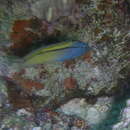Life Cycle
provided by Fishbase
Oviparous, distinct pairing (Ref. 205).
Trophic Strategy
provided by Fishbase
Swims above the bottom. Feeds on zooplankton.
- Recorder
- Drina Sta. Iglesia
Biology
provided by Fishbase
Adults swim above the bottom (Ref. 9710). Juveniles observed to mingle with apogonid fishes among Diadema spines as a means of protection against predators like Pterois (Ref. 79545). Adults feed on zooplankton (Ref. 9710). Oviparous. Eggs are demersal and adhesive (Ref. 205), and are attached to the substrate via a filamentous, adhesive pad or pedestal (Ref. 94114). Larvae are planktonic, often found in shallow, coastal waters (Ref. 94114).
- Recorder
- Estelita Emily Capuli
Meiacanthus nigrolineatus: Brief Summary
provided by wikipedia EN
Meiacanthus nigrolineatus, the blackline fangblenny, is a blenny from the Western Indian Ocean. This species grows to a length of 9.5 centimetres (3.7 in) TL. This venomous species occasionally makes its way into the aquarium trade.
- license
- cc-by-sa-3.0
- copyright
- Wikipedia authors and editors
Description
provided by World Register of Marine Species
Predaceous fishes learn to avoid this species due to its venomous bite.Mimicked by two other blennies.
Randall, J. E. (1992). Red Sea Reef Fishes. Immel Publishing.
- license
- cc-by-4.0
- copyright
- WoRMS Editorial Board

